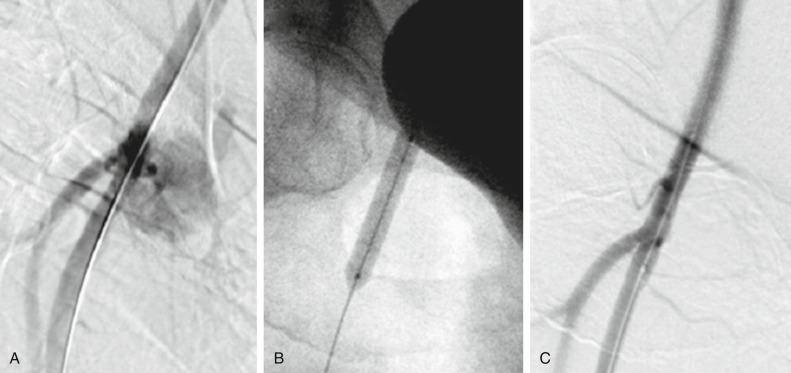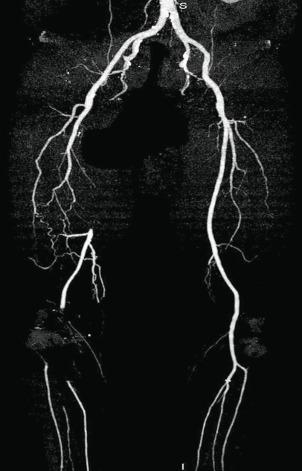Physical Address
304 North Cardinal St.
Dorchester Center, MA 02124
The concept of percutaneous catheter-based peripheral vascular intervention (PVI) was first described by Charles Dotter and further advanced with the development of balloon dilation catheters by Andreas Gruentzig. Catheter-based revascularization has largely replaced conventional open surgery as the treatment of first choice in selected patients treated for lower-extremity ischemia.
No single specialty program (cardiology, radiology, or surgery) offered training that satisfied the entire skill set needed to perform peripheral endovascular intervention ( Table 20.1 ). Recognition of this unmet need for a trained cadre of clinicians to care for patients with peripheral artery disease (PAD) prompted the development of a core cardiology training symposium (COCATS-4) to codify the necessary cardiology fellowship training.
| Skill Element | Description |
|---|---|
| Cognitive | Extensive knowledge of vascular disease, including natural history, pathophysiology, diagnostic methods, and treatment alternatives |
| Technical | Competence in both diagnostic angiography and interventional techniques, such as the use and selection of balloons, guidewires, stents, and emboli protection devices |
| Clinical | Ability to manage inpatients, interpret laboratory tests, obtain informed consent, assess risk/benefit ratio, and admitting privileges |
The Society for Cardiovascular Angiography and Interventions (SCAI) published revised Appropriate Use Criteria (AUC) for endovascular therapy (EVT) for atherosclerotic PAD. The peripheral AUC were developed to assist clinicians’ decision making, to improve patients’ understanding regarding relative risks and benefits of a procedure, and to guide future research. Clinical scenarios were described in which catheter-based intervention was classified as “appropriate,” “may be appropriate,” or “rarely appropriate,” incorporating the best clinical and scientific evidence, cost-effectiveness data, and the consensus of experts.
Patient selection for catheter-based vascular intervention depends upon both anatomical and functional criteria ( Table 20.2 ). Anatomical lesion criteria include the ability to gain vascular access, a reasonable likelihood of crossing the lesion with a guidewire, and the expectation that a therapeutic catheter can be advanced across the target lesion. Vascular access site complications following catheter-based procedures are preferentially treated with percutaneous therapy ( Fig. 20.1 ). Patients with hypotension and a high suspicion of bleeding after common femoral artery (CFA) access require urgent diagnostic angiography from the contralateral femoral artery to determine the bleeding site. Rapid identification of the bleeding site may provide an opportunity for lifesaving hemostasis with balloon tamponade.
| Fontaine | Rutherford | |||
|---|---|---|---|---|
| Stage | Clinical | Grade | Category | Clinical |
| I | Asymptomatic | 0 | 0 | Asymptomatic |
| IIa | Mild claudication | I | 1 | Mild claudication |
| IIb | Moderate to severe claudication | I I |
2 3 |
Moderate claudication Severe claudication |
| III | Rest pain | II | 4 | Rest pain |
| IV | Ulceration or gangrene | III IV |
5 6 |
Minor tissue loss Ulceration or gangrene |

Functional criteria to select patients for peripheral endovascular revascularization typically include lifestyle or vocation-limiting symptoms of claudication, critical limb ischemia (CLI; rest pain, nonhealing ulcers, or gangrene), or acute limb ischemia. Asymptomatic patients with anatomically suitable iliac artery lesions are not considered candidates for PVI unless it is to facilitate vascular access, such as for intra- aortic counterpulsation balloon placement or for vascular access to perform coronary intervention.
Patients with lifestyle-limiting symptoms of claudication, and without heart failure, should first be treated with pharmacological therapy, cilostazol 100 mg bid, and structured exercise training before revascularization is attempted. If exercise training and pharmacotherapy are not effective, if patients are intolerant of cilostazol or cannot be treated with the drug because of heart failure (black box warning), or if a supervised exercise program is unavailable, an attempt at endovascular intervention is appropriate. In general, patients with claudication rarely progress to limb loss, so endovascular revascularization is reserved for those patients with favorable anatomy who either fail conservative therapy and have lifestyle-limiting symptoms, or who have vocation- limiting symptoms. The therapeutic goals for claudicants are symptom relief, increased walking distance, plus improved functionality and quality of life (QOL). For this reason, the durability of patency after the procedure is performed becomes important.
Patients with CLI or limb-threatening ischemia (gangrene, nonhealing ulcer, or rest pain) are candidates for urgent revascularization. When considering a patient with CLI for revascularization, it is important to remember that multilevel disease (iliac, femoral, and tibial) is likely to be present and that simply improving “inflow” without addressing the more distal vascular lesions or runoff vessels may fail to solve the clinical problem. Patients with CLI typically have more extensive disease than claudicants and require urgent revascularization to prevent tissue loss (see Table 20.2 ).
The prognosis for patients presenting with CLI is poor. Those with tobacco abuse and/or diabetes are 10 times more likely to require amputation. Patients with CLI tend to be older, with almost 50% of patients older than 80 years undergoing amputations. Within 3 months of presentation, 12% will require an amputation, and 9% will die; the 1-year mortality rate is 22%. Anatomy suitable for EVT is often present in one or more below-knee vessels. Therapy should be designed to restore pulsatile straight-line flow to the distal part of the limb, with as low a procedural morbidity as possible. The guiding principle is that less blood flow is required to maintain tissue integrity than to heal a wound, so restenosis does not usually result in recurrent CLI unless there has been repeated injury to the limb. Therefore, the emphasis is less on long-term vessel patency and more on limb salvage.
The Bypass versus Angioplasty in Severe Ischaemia of the Leg (BASIL) trial was a multicenter randomized trial comparing an initial strategy of balloon angioplasty (percutaneous transluminal angioplasty [PTA]) to open surgery in 452 patients with CLI. The primary outcome was time to amputation or death (amputation-free survival). Surgery had significantly greater length of stay and needed significantly more intensive care unit (ICU) care than did those allocated angioplasty. The cost was about one-third lower for patients assigned an angioplasty-first strategy. Beyond 2 years there was a significantly reduced hazard in amputation-free survival (adjusted hazard ratio [HR] 0.37 [95% confidence interval [CI]: 0.17–0.77], P = .008) and all-cause mortality (HR 0.34 [95% CI: 0.17–0.71], P = .004) for surgery relative to angioplasty. For patients with limb-threatening lower extremity ischemia and an estimated life expectancy of < 2 years , or in patients in whom an autogenous vein conduit is not available, balloon angioplasty is reasonable to perform (when possible) as the initial procedure to improve distal blood flow. For patients with limb-threatening ischemia and an estimated life expectancy of > 2 years , bypass surgery (when possible) if an autogenous vein conduit is available, is reasonable to perform as the initial treatment to improve distal blood flow.
It is very likely that major advances in endovascular technology, including drug-coated balloons (DCB) and drug-eluting stents (DES) will have further improved the outcomes of endo-first treated patients relative to conventional bypass surgery. The ongoing BEST-CLI trial is expected to help inform our decision making.
Relative contraindications to catheter-based PVI include lesions likely to generate atheroemboli, and lesions that are not dilatable. Other relative contraindications include any other instances in which risks of the procedure seem to outweigh the potential benefits. For example, patients unlikely to be independent or ambulatory, and the risk of contrast-induced nephropathy in a patient with severe renal impairment, must be weighed against expected functional improvement.
Prior to performing peripheral endovascular intervention, the patient should have a complete cardiovascular evaluation, with specific attention directed to the status of atherosclerotic risk factors. Atherosclerosis is a systemic disease, and appropriate risk-factor modification (tobacco- cessation counseling, treatment of lipids to target values), screening tests for cardiovascular diseases, and optimization of medical therapy should be performed.
Prior to performing lower-extremity endovascular intervention, it is necessary to objectively determine the patient’s functional status. A history, physical examination, and appropriate noninvasive testing should be obtained prior to planning peripheral endovascular revascularization. If the patient is ambulatory, a rest and exercise ankle-brachial index (ABI) should be measured, and pulse volume recordings (PVRs) should be performed. Other noninvasive modalities, such as vascular ultrasound, or alternative imaging modalities, such as magnetic resonance angiography (MRA) or computed tomographic angiography (CTA), may be helpful to resolve conflicting data and are used at the discretion of the physician ( Fig. 20.2 ). When planning lower-extremity revascularization, status of the inflow and outflow vessels relative to the target lesion must be visualized angiographically. This is usually done with invasive diagnostic angiography, but in selected patients, MRA or CTA may be very useful.

The only premedication requirement for peripheral endovascular intervention is aspirin therapy (81 to 325 mg daily). The use of other antiplatelet agents is optional since there is no evidence that their use improves procedural success or decreases complications. If the patient is intolerant to aspirin, a thienopyridine drug would be appropriate. There is no objective evidence supporting the benefit of dual antiplatelet therapy after EVT or following peripheral vascular stent placement.
There is no standard for anticoagulation therapy, except to state that intravenous unfractionated heparin (UFH), in a dose up to 5000 International Units, is commonly used to achieve an activated clotting time (ACT) of 250 to 300 seconds. At present, there is no evidence that the use of glycoprotein (GP)-IIb/IIIa platelet receptor antagonists, low-molecular-weight heparins, or antithrombins improve procedural efficacy or safety for PVI.
The first step to ensure a successful procedure is to select the most appropriate vascular access. The majority of peripheral endovascular interventions can be performed from multiple arterial access sites (i.e., radial, brachial, femoral, or popliteal arteries). However, cases occasionally require a specific access to achieve a successful result. Consequently, familiarity with a variety of vascular access sites and techniques is one of the most important components of the basic skill set. The ability to gain both retrograde and antegrade common femoral access is a required skill for the peripheral vascular interventionalist. An infrapopliteal target lesion may be best approached with antegrade femoral access, whereas a proximal superficial femoral artery (SFA) lesion may require a contralateral retrograde femoral approach. Occasionally, bilateral retrograde femoral artery access is desirable—for example, when treating a common iliac bifurcation lesion. Finally, there will be times when the antegrade approach fails and distal tibial access is required for a retrograde approach to an occlusion.
Become a Clinical Tree membership for Full access and enjoy Unlimited articles
If you are a member. Log in here